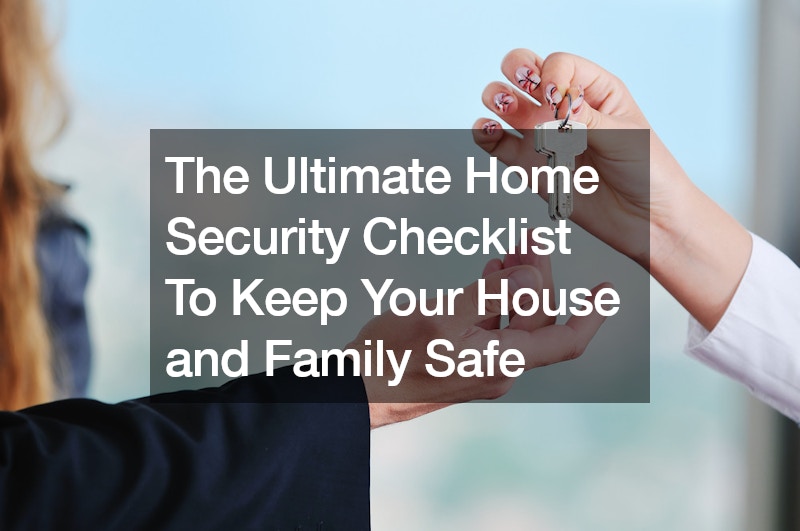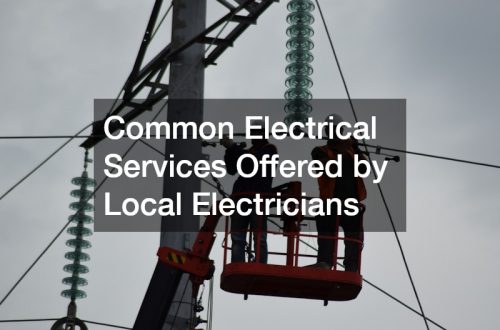
“`html
The Ultimate Home Security Checklist To Keep Your House and Family Safe
Ensuring the safety and security of your home and family is a top priority for many. With increasing concerns about burglary, vandalism, and other security threats, having a comprehensive home security checklist can be a lifesaver. This article aims to provide a detailed home security checklist to help you safeguard your property and loved ones. Let’s delve into the key aspects that everyone should consider.
1. How Can I Improve My Home’s Perimeter Security?

Improving your home’s perimeter security is the first line of defense for protecting your property. Here are the key elements to consider:
Fencing and Gates
- Install sturdy fencing: A high, strong fence made of materials like wrought iron or reinforced wood can deter intruders.
- Secure gates: Gates should be as robust as the fencing and equipped with reliable locks or automatic controls.
- Regular maintenance: Inspect and repair any damage to maintain effectiveness.
Outdoor Lighting
- Motion-activated lights: Install lights that turn on with movement, illuminating dark areas and startling intruders.
- Strategic placement: Place lights near entry points, pathways, and potential hiding spots.
- Solar-powered options: Solar-powered lights can act as a generator, providing consistent security lighting even during power outages.
Shrubbery and Landscaping
- Trim bushes and trees: Keep shrubbery well-trimmed to eliminate hiding spots near windows and doors.
- Defensive planting: Use thorny plants like holly or rose bushes beneath windows and along fences to deter intruders.
- Clear paths: Ensure pathways to your home are clear and visible from the street.
2. What Are the Best Practices for Securing Entry Points?

Securing entry points is crucial for enhancing your home’s security against potential threats. Here are the best practices to consider:
Door Locks and Deadbolts
- Upgrade to high-security locks: Install deadbolts that are resistant to picking, drilling, and forced entry techniques.
- Use smart locks: Consider smart locks that offer features like remote locking/unlocking and activity logs, enhancing convenience and security.
- Reinforce door frames: Use longer screws to secure door strike plates and consider a door reinforcement kit for added strength.
Window Security
- Install window locks: Ensure all windows are equipped with locks that are in good working condition.
- Consider window bars or grilles: Particularly for basement or ground-level windows, bars or grilles can add an extra layer of physical security.
- Tempered glass or security film: For windows that are vulnerable to break-ins, applying security film or using tempered glass can make them more resistant to impact.
Garage Safety
- Secure garage doors: Use a robust garage door opener with rolling code technology to prevent code grabbing by thieves.
- Keep garage windows secure: Apply window locks or security film to garage windows to prevent unauthorized entry.
- Control garage door access: Ensure garage door remotes are secure and limit access to spare keys.
Considering these best practices for securing entry points during home remodeling projects ensures that your home is well-protected against intruders. By integrating advanced locks, window security measures, and garage safety enhancements, you can significantly enhance your home’s overall security posture while undertaking essential home remodeling tasks.
3. How Effective Are Security Cameras?

Security cameras play a pivotal role in modern home security systems, offering surveillance and peace of mind. Here’s what you need to know about their effectiveness:
Types of Security Cameras
- Outdoor cameras: These are designed to withstand various weather conditions and provide a clear view of the exterior of your home. Look for features like infrared night vision and HD resolution.
- Indoor cameras: Ideal for monitoring interior spaces, such as entryways, living rooms, or storage areas. Some models offer two-way audio communication.
- Wireless cameras: Easy to install and often equipped with Wi-Fi connectivity, allowing remote access via smartphone apps.
- PTZ (Pan-Tilt-Zoom) cameras: These cameras can be remotely controlled to pan, tilt, and zoom to capture specific areas or activities.
Placement of Cameras
- Entry points: Install cameras at all entry points, including doors and windows, to monitor who enters and exits your home.
- Driveways and pathways: Cover driveways and paths leading to your home to capture footage of approaching vehicles or individuals.
- Garage and backyard: Protect vulnerable areas like garages or backyard where valuable items may be stored.
Monitoring and Maintenance
- Regular checks: Ensure cameras are properly positioned and free from obstructions like cobwebs or debris that could affect visibility.
- Monitoring service: Consider a professional monitoring service offered by a residential roofing contractor for real-time surveillance and quick response to security alerts.
- Data storage: Choose between cloud storage or local storage options to store video footage securely.
By strategically selecting and placing security cameras, and ensuring regular monitoring and maintenance, you can maximize their effectiveness in safeguarding your home. Integrating these measures during your home security enhancement with a residential roofing contractor ensures comprehensive protection and peace of mind for you and your family
4. What Role Do Alarm Systems Play in Home Security?
Alarm systems are crucial components of a comprehensive home security strategy, providing both deterrence and immediate response capabilities. Here’s a breakdown of their significance:
Types of Alarm Systems
- Burglar alarms: Triggered by unauthorized entry, these alarms emit loud sirens to alert residents and potentially scare off intruders.
- Fire alarms: Detect smoke or excessive heat, sounding alarms to warn occupants and potentially alerting emergency services.
- Carbon monoxide alarms: Monitor CO levels, emitting alerts if dangerous concentrations are detected, crucial for home safety.
Integration with Smart Home Devices
- Smartphone control: Many modern alarm systems can be controlled remotely via smartphone apps, allowing users to arm/disarm and receive alerts from anywhere.
- Integration with smart locks: Coordinate alarm and locking systems to enhance overall security measures.
- Compatibility with voice assistants: Some systems integrate with voice-controlled devices for hands-free operation.
Alarm System Features
- Motion sensors: Detect movement within designated areas, triggering alarms and alerting homeowners or monitoring services.
- Window and door sensors: Monitor entry points, sounding alarms if breached.
- Backup power: Ensure continued operation during power outages, crucial for maintaining security.
Integrating alarm systems into your home security plan, with the guidance of local roofers familiar with the latest in security technology, ensures tailored protection. Their expertise can extend beyond roofing to include comprehensive home safety measures, enhancing peace of mind for you and your family.
5. How Important Is Interior Security?
Interior security measures are essential for safeguarding your home and family members. Here are key aspects to consider:
Safe Room Design
- Purpose-built spaces: Designate a safe room or area fortified to withstand intrusion or natural disasters.
- Reinforced doors and walls: Install sturdy doors and reinforced walls that provide a secure refuge.
- Communication tools: Equip with emergency supplies, communication devices, and a means to contact emergency services if needed.
Secure Storage Solutions
- Lockable cabinets and safes: Store valuables, important documents, and hazardous items securely.
- Hidden compartments: Install hidden compartments or storage areas to conceal valuables.
- Access control: Limit access to sensitive areas with secure locks and keys.
Interior Lighting and Timers
- Timed lighting: Use timers to simulate occupancy when away, deterring potential burglars.
- Motion-activated lights: Illuminate dark areas, enhancing safety and visibility.
- Emergency lighting: Install backup lighting to navigate during power outages.
By prioritizing interior security, including safe room design, secure storage solutions, and strategic lighting with timers, you ensure a safe and secure environment for your family and childcare needs.
6. How Can I Protect My Home Against Fire and Carbon Monoxide?
Protecting your home against fire and carbon monoxide (CO) is crucial for the safety of your household. Here are effective measures to implement:
Smoke and Carbon Monoxide Detectors
- Placement: Install detectors on every level of your home, including inside bedrooms and near kitchen areas.
- Testing and maintenance: Test detectors monthly and replace batteries annually to ensure they are functioning properly.
- Interconnected systems: Opt for interconnected detectors so that when one alarm sounds, all alarms in the home activate.
Fire Extinguishers and Fire Blankets
- Accessibility: Place fire extinguishers in key locations, such as the kitchen, garage, and near heating appliances.
- Training: Familiarize yourself and your family with operating fire extinguishers and using fire blankets effectively.
- Regular inspections: Check extinguishers regularly to ensure they are charged and ready for use.
Fire Safety Drills and Plans
- Create an escape plan: Develop and practice a fire escape plan with clear routes and meeting points outside the home.
- Designate responsibilities: Assign roles during drills, such as who will assist children or pets to safety.
- Review regularly: Update your fire safety plan regularly and conduct drills at least twice a year.
By integrating these fire and CO protection measures, alongside essential kitchen remodeling projects, you can enhance safety and preparedness in your home. Seeking advice from professionals, such as local roofers experienced in safety considerations, can further ensure comprehensive protection tailored to your household’s needs.
7. What Should I Consider for Digital Security?
Digital security is crucial in safeguarding your personal information and home network from cyber threats. Here are essential considerations:
Securing Wi-Fi Networks
- Change default settings: Modify default router settings, including network name (SSID) and administrator passwords, to enhance security.
- Use strong encryption: Enable WPA2 or WPA3 encryption protocols on your Wi-Fi network for secure communication.
- Update firmware: Regularly update router firmware to patch security vulnerabilities.
Password Protection
- Create strong passwords: Use complex passwords combining letters, numbers, and special characters for all accounts.
- Enable two-factor authentication (2FA): Add an extra layer of security by requiring a second form of verification for account access.
- Password managers: Consider using a reputable password manager to securely store and generate passwords.
Protecting Personal Data
- Encrypt sensitive data: Use encryption tools or software to protect sensitive files and information stored on your devices.
- Be cautious with sharing: Limit sharing personal information online and verify the authenticity of websites before entering sensitive data.
- Regular backups: Backup important data regularly to an external hard drive or cloud storage service.
By prioritizing digital security measures, including securing Wi-Fi networks and implementing robust password protection practices, you can mitigate risks of cyber threats effectively. Seeking advice from HVAC companies experienced in network security can provide additional insights tailored to enhancing your home’s digital defenses. Additionally, enjoy leisure time with challenging crossword puzzle books to unwind while ensuring your digital security remains intact
8. How Can I Educate My Family About Security?
Educating your family about security is vital for ensuring everyone’s safety and readiness. Here are key strategies to implement:
Teaching Children About Safety
- Establish clear guidelines: Teach children about not sharing personal information online and the importance of never opening doors to strangers.
- Role-playing: Practice scenarios where children can identify safe versus risky situations and how to react appropriately.
- Involve lawn care contractors: They can help explain safe practices related to outdoor security and landscaping.
Establishing Emergency Protocols
- Create an emergency plan: Develop a comprehensive plan covering various scenarios like fires, intrusions, or natural disasters.
- Designate meeting points: Determine safe meeting places both inside and outside the home in case of emergencies.
- Practice drills: Conduct regular drills to ensure everyone knows their roles and actions during emergencies.
Regular Family Meetings
- Discuss security updates: Use meetings to review and update security measures like alarm systems and door locks.
- Address concerns: Encourage open discussions about any security concerns or incidents that family members may have encountered.
- Reinforce safety practices: Continuously reinforce the importance of security habits like locking doors and windows.
By involving lawn care contractors who understand outdoor security aspects, such as lighting and landscaping, you can provide comprehensive education on home safety. Empowering your family through education and regular communication ensures everyone is prepared and proactive in maintaining a secure home environment.
9. What Should I Include in a Vacation Security Checklist?
Preparing a vacation security checklist is crucial to protect your home while you’re away. Here are essential steps to consider:
Informing Neighbors and Friends
- Notify trusted neighbors: Inform them of your travel plans and provide contact information in case of emergencies.
- Request assistance: Ask neighbors to keep an eye on your property, collect mail/packages, and report any suspicious activity.
Securing Valuables
- Lock up valuables: Store important documents, jewelry, and electronics in a safe or secure location.
- Use a plumber to check for leaks: Ensure all windows and doors are securely locked and consider installing additional locks or security measures if necessary.
- Consider storing valuable items in a safe deposit box: If you have valuable items that you do not need to access on a regular basis
10. How Do I Maintain and Update My Home Security Checklist?
Maintaining and updating your home security checklist is essential to ensure ongoing protection for your property and loved ones. Here’s how you can stay proactive:
Regular Inspections and Audits
- Scheduled checks: Conduct regular inspections of your home’s security measures, including alarms, locks, and cameras.
- Address vulnerabilities: Identify and fix any issues such as broken locks, malfunctioning alarms, or areas with poor lighting.
- Review emergency plans: Ensure all family members are familiar with emergency procedures and update contact information if necessary.
Upgrading Outdated Systems
- Evaluate technology: Stay informed about advancements in home security technology, such as smart locks or updated alarm systems.
- Consult professionals: Seek advice from security experts or local contractors to assess the effectiveness of your current systems.
- Budget for upgrades: Allocate resources for upgrading outdated equipment or implementing new security features as needed.
Conclusion
Maintaining a secure home requires ongoing effort and vigilance. Following this ultimate home security checklist will help you cover all bases, from improving physical security and integrating technology to ensuring everyone at home is aware and prepared. Remember, the safety of your home and family is paramount, and taking these proactive steps can provide peace of mind in an increasingly uncertain world.





